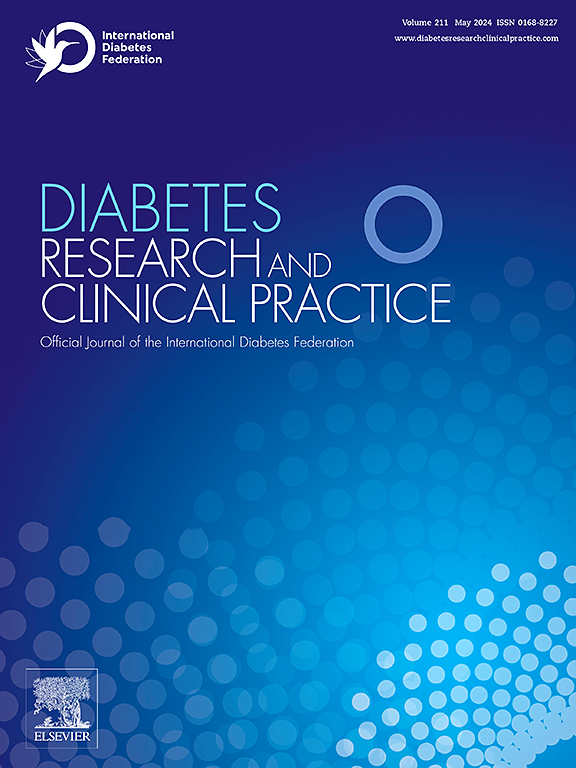比较限时进食与标准饮食疗法对 2 型糖尿病患者血糖控制的影响:随机对照试验。
IF 6.1
3区 医学
Q1 ENDOCRINOLOGY & METABOLISM
引用次数: 0
摘要
目的:测试限时进食(TRE)与营养师指导的个体化膳食相比对改善 2 型糖尿病患者 HbA1c 的效果:在平行分组设计中,51 名 2 型糖尿病和超重/肥胖(HbA1c ≥6.5% (48 mmol/mol),体重指数≥25-≤40 kg/m2)的成人(35-65 岁)开始了为期 6 个月的干预。基线之后,参与者被随机分配到 TRE(1000-1900 小时)或 DIET(个性化饮食指导),在四个月内接受四次咨询。采用线性混合模型对 HbA1c(主要指标)、身体成分和自我报告的依从性(次要指标)的变化进行分析。先验设定的非劣效边际为 0.3%(4 毫摩尔/摩尔)HbA1c:43 名参与者(56 ± 8 岁,体重指数:33 ± 5 kg/m2,HbA1c:7.6 ± 0.8%)完成了干预。HbA1c 降低了(P=0.002;TRE:-0.4%(-5 mmol/mol),DIET:-0.3%(-4 mmol/mol)):-TRE 不劣于 DIET(-0.11%,95%CI:-0.50% 至 0.28%)。两组的体重都通过每天自发能量减少 900 千焦的方式有所下降(PConclusions.TRE:-1.7 千克;DIET:-1.2 千克):当个体化饮食指导不可用、无效和/或不合适时,TRE 可能是改善 2 型糖尿病患者血糖控制的另一种饮食策略。本文章由计算机程序翻译,如有差异,请以英文原文为准。
Comparing the effects of time-restricted eating on glycaemic control in people with type 2 diabetes with standard dietetic practice: A randomised controlled trial
Aims
To test the efficacy of time-restricted eating (TRE) in comparison to dietitian-led individualised dietary guidance to improve HbA1c in people with Type 2 diabetes mellitus.
Methods
In a parallel groups design, 51 adults (35–65 y) with Type 2 diabetes mellitus and overweight/obesity (HbA1c ≥6.5% (48 mmol/mol), BMI ≥25-≤40 kg/m2) commenced a six-month intervention. Following baseline, participants were randomised to TRE (1000–1900 h) or DIET (individualised dietetic guidance) with four consultations over four months. Changes in HbA1c (primary), body composition, and self-reported adherence (secondary) were analysed using linear mixed models. A non-inferiority margin of 0.3% (4 mmol/mol) HbA1c was set a priori.
Results
Forty-three participants (56 ± 8 y, BMI: 33 ± 5 kg/m2, HbA1c: 7.6 ± 0.8%) completed the intervention. HbA1c was reduced (P=0.002; TRE: −0.4% (−5 mmol/mol), DIET: −0.3% (−4 mmol/mol)) with no group or interaction effects; TRE was non-inferior to DIET (−0.11%, 95%CI: −0.50% to 0.28%). Body mass reduced in both groups (TRE: −1.7 kg; DIET: −1.2 kg) via ∼900 kJ/d spontaneous energy reduction (P<0.001). Self-reported adherence was higher in TRE versus DIET (P<0.001).
Conclusions
When individualised dietary guidance is not available, effective, and/or suitable, TRE may be an alternative dietary strategy to improve glycaemic control in people with Type 2 diabetes mellitus.
求助全文
通过发布文献求助,成功后即可免费获取论文全文。
去求助
来源期刊

Diabetes research and clinical practice
医学-内分泌学与代谢
CiteScore
10.30
自引率
3.90%
发文量
862
审稿时长
32 days
期刊介绍:
Diabetes Research and Clinical Practice is an international journal for health-care providers and clinically oriented researchers that publishes high-quality original research articles and expert reviews in diabetes and related areas. The role of the journal is to provide a venue for dissemination of knowledge and discussion of topics related to diabetes clinical research and patient care. Topics of focus include translational science, genetics, immunology, nutrition, psychosocial research, epidemiology, prevention, socio-economic research, complications, new treatments, technologies and therapy.
 求助内容:
求助内容: 应助结果提醒方式:
应助结果提醒方式:


